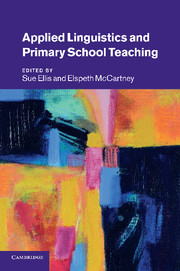Book contents
- Frontmatter
- Contents
- List of figures
- List of tables
- Notes on contributors
- Preface
- Editors' notes and conventions
- Introduction
- Part I Policy and diversity in the twenty-first-century primary school
- Part II The range and focus of applied linguistics research
- Introduction to Part II
- 6 Grammar for designers: how grammar supports the development of writing
- 7 The use of corpus-based approaches in children's knowledge about language
- 8 Words and pictures: towards a linguistic understanding of picture books and reading pedagogy
- 9 From storytellers to narrators: how can the history of reading help with understanding reading comprehension?
- 10 Talk about text: the discursive construction of what it means to be a reader
- 11 Why we need to know about more than phonics to teach English literacy
- 12 Understanding children's reading comprehension difficulties
- 13 Classroom discourse: the promise and complexity of dialogic practice
- 14 Pedagogy and bilingual pupils in primary schools: certainties from applied linguistics
- Part III Empowering teachers and teachers' use of knowledge
- References
- Index
11 - Why we need to know about more than phonics to teach English literacy
Published online by Cambridge University Press: 26 April 2011
- Frontmatter
- Contents
- List of figures
- List of tables
- Notes on contributors
- Preface
- Editors' notes and conventions
- Introduction
- Part I Policy and diversity in the twenty-first-century primary school
- Part II The range and focus of applied linguistics research
- Introduction to Part II
- 6 Grammar for designers: how grammar supports the development of writing
- 7 The use of corpus-based approaches in children's knowledge about language
- 8 Words and pictures: towards a linguistic understanding of picture books and reading pedagogy
- 9 From storytellers to narrators: how can the history of reading help with understanding reading comprehension?
- 10 Talk about text: the discursive construction of what it means to be a reader
- 11 Why we need to know about more than phonics to teach English literacy
- 12 Understanding children's reading comprehension difficulties
- 13 Classroom discourse: the promise and complexity of dialogic practice
- 14 Pedagogy and bilingual pupils in primary schools: certainties from applied linguistics
- Part III Empowering teachers and teachers' use of knowledge
- References
- Index
Summary
Introduction
The triangle formed by the relationship between a teacher, a learner, and the object to be learned is a common way of representing what teachers need to know when teaching their pupils. Teachers' knowledge of the content to be learned is referred to as subject matter knowledge; their knowledge of how students learn about this object, of their conceptions (or misconceptions) before they are taught and how their knowledge changes through instruction, is known as pedagogical content knowledge (Schulman 1986; Strauss et al. 1999). Schulman argued that subject-matter knowledge for teaching is more than what is expected of the subject major who is not preparing for teaching. ‘We expect the teacher to understand why a given topic is particularly central to a discipline whereas another may be somewhat peripheral. This will be important in subsequent pedagogical judgments regarding relative curricular emphasis’ (Schulman 1986: 9). Schulman proposed that pedagogical content knowledge must include knowledge of ‘the most useful forms of representation of those ideas [to be taught], the most powerful analogies, illustrations, examples, explanations, and demonstrations – in a word, the ways of representing and formulating the subject that make it comprehensible to others’ (Schulman 1986: 9). Schulman's distinction between these two forms of knowledge, and the emphasis on the connections between them, is a landmark for many who are concerned with teacher education.
- Type
- Chapter
- Information
- Applied Linguistics and Primary School Teaching , pp. 140 - 153Publisher: Cambridge University PressPrint publication year: 2011
- 2
- Cited by



